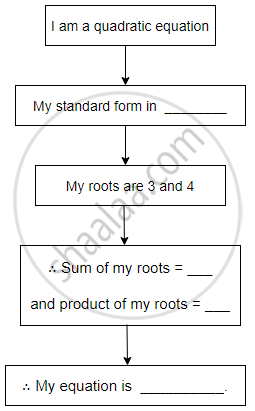Advertisements
Advertisements
प्रश्न

In the adjoining fig. `square` ABCD is a trapezium AB || CD and its area is 33 cm2. From the information given in the figure find the lengths of all sides of the `square` ABCD. Fill in the empty boxes to get the solution.
Solution: `square` ABCD is a trapezium.
AB || CD
`"A"(square "ABCD") = 1/2 ("AB" + "CD") xx`______
33 = `1/2 ("x" + 2"x" + 1) xx `______
∴ ______ = (3x + 1) × ______
∴ 3x2 +______ − ______ = 0
∴ 3x(______) + 10(______) = 0
∴ (3x + 10) (______) = 0
∴ (3x + 10) = 0 or ______ = 0
∴ x = `-10/3` or x = ______
But length is never negative.
∴ `"x" ≠ -10/3`
∴ x = ______
AB = ______, CD = ______, AD = BC = ______
उत्तर
`square` is a trapezium.
AB || CD
`"A"(square "ABCD") = 1/2 ("AB" + "CD") xx bb"AM"`
33 = `1/2 ("x" + 2"x" + 1) xx bb(("x" - 4))`
∴ 66 = (3x + 1) × (x − 4)
∴ 66 = 3x(x − 4) + 1(x − 4)
∴ 0 = 3x2 − 12x + 1x − 4 − 66
∴ 0 = 3x2 − 11x − 70
∴ 3x2 − 11x − 70 = 0
∴ 3x2 − 21x + 10x − 70 = 0 .....`[(-21 xx 10 = -210),(-21 + 10 = -11)]`
∴ 3x(x − 7) + 10(x − 7) = 0
∴ (3x + 10) (x − 7) = 0
∴ (3x + 10) = 0 or (x − 7) = 0
∴ 3x = -10 or x = 7
∴ x = `-10/3` or x = 7
But length is never negative.
∴ `"x" ≠ -10/3`
∴ x = 7
AB = 7, CD = 15, AD = BC = 5
APPEARS IN
संबंधित प्रश्न
If one root of the equation `2x^2+ax+6=0` 2 then a=?
(a)7 (b)-7 (c) 7/2 (d)-7/2
In the equation `ax^2+bx+c=0` it is given that `D=(b^2-4ac)>0`
equation are
(a) real and equal (b) real and unequal (c) imaginary (d) none of these
The roots of the equation 2x^2-6x+7=0 are
(a) real, unequal and rational (b) real, unequal and irrational (c) real and equal (d) imaginary
The sum of a number and its reciprocal is `2 1/20` The number is
(a) `5/4 or 4/5` (b)`4/3 or 3/4`
(c) `5/6 or 6/5` (d) `1/6 or 6`
The perimeter of a rectangle is 82m and its area is `400m^2` . The breadth of the rectangle is
(a) 25m (b)20m
(c) 16m (d)9m
The length of a rectangular field exceeds its breadth by 8 m and the area of the field is `240 m^2` . The breadth of the field is
(a) 20 m (b) 30 m (c) 12 m (d) 16 m
If `x=-1/2` is a solution of the quadratic equation `3x^2+2kx-3=0`
Find the value of k.
If the roots of the quadratic equation `2x^2+8x+k=0` are equal then find the value of k.
If the roots of the quadratic equation `px(x-2)+=0` are equal, find the value of p.
Find the value of k so that the quadratic equation` x^2-4kx+k=0`
has equal roots.
Solve `sqrt3x^2+10x-8sqrt3=0`
Solve` x^2-4ax+4a^2-b^2=0`
Decide whether the following equation is quadratic equation or not.
m3 + 3m2 – 2 = 3m3
In the orange garden of Mr. Madhusudan there are 150 orange trees. The number of trees in each row is 5 more than that in each column. Find the number of trees in each row and each column with the help of following flow chart.

Which one is the quadratic equation?
Solve the following quadratic equation.
`1/(x + 5) = 1/x^2`
Find the value of m so that the quadratic equation mx (x − 7) + 49 = 0 has two equal roots.
Obtain a quadratic equation whose roots are –3 and –7.
For the quadratic equation 3x2 + 2x - 1 = 0 , find the value of the discriminant.
Complete the following activity to form a quadratic equation.
Activity:

